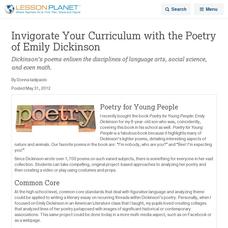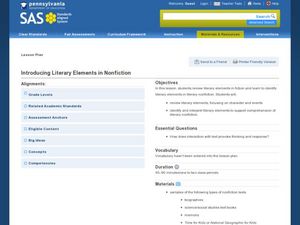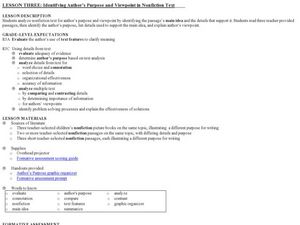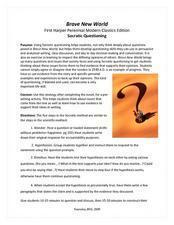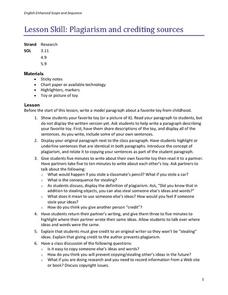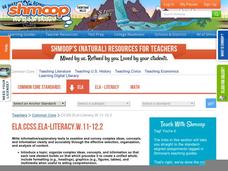Curated OER
Invigorate Your Curriculum with the Poetry of Emily Dickinson
Dickinson’s poems enliven the disciplines of language arts, social science, and even math.
Southern Nevada Regional Professional Development Program
Pardon Me, Your Modifier is Dangling
Lost! (or misplaced) a modifier. Last seen dangling at the end of a sentence! Reward offered! To underscore the humor, class members are each given a sample sentence to illustrate (A woman passed by, leading a Springer Spaniel, in a...
Childnet International
Self Esteem
To middle schoolers, there's nothing worse than being excluded from a peer group. Developing important self-esteem skills can not only get them through awkward adolescent times, it can carry them through the rest of their lives as...
Have Fun Teaching
Common Core 1st Grade Workbook
You've found the first grade Common Core jackpot! English Language Arts and Math Common Core standards are addressed in a 74-page packet complete with standard text printables, activities, cut-outs for the classroom, and worksheets.
EngageNY
Launching Readers Theater Groups: Identifying Passages from Esperanza Rising for Readers Theater that Connect to the UDHR
Teach young readers how to compare two texts and select passages that exemplify a specific theme with Lesson 6 from Unit 3. Begin by modeling how an expert reader selects examples from a text, performing a think aloud on how Article 2 of...
Curated OER
What is a Paragraph? Part Two
Paragraphs are simply visual cues to separate information. Briefly display the different types of paragraph organization with these slides. A good tool for beginning readers and writers.
Curated OER
Introducing Literacy Elements in Nonfiction
Explore nonfiction writing with your class. They will identify elements in nonfiction by reviewing elements of fiction. Then they use biographies, memoirs, menus, Time for Kids, and text books to identify elements of nonfiction. They...
Curated OER
Identifying Author’s Purpose and Viewpoint in Nonfiction Text
Why do people write books? Pupils discover how to identify the author's viewpoint. They read non-fiction passages their instructor selects (the plan has the class look at nonfiction children's picture books), and then identify the...
Curated OER
Retell And Summarize Text
Help your learners read a text and summarize it using their own words. The main idea and important details of an article are discussed before individuals write their summaries. To support discernment about what to include in a summary,...
Curated OER
Call of the Wild: After-reading Response Strategy
Readers select a character from Call of the Wild, record their responses to a series of prompts in a spiral notebook, and use details from the novel to support their thinking. The spirals are then used as source material to support...
Curated OER
Character Traits
Using a three-column chart labeled "Character," "Action," and "Trait," pupils analyze the traits of several characters from a short story. The instructional activity is designed for a SMART board, but a teacher could easily do the...
Curated OER
Capitals, Designers & Common Fashion Terms
The importance of fashion on society is identified and new vocabulary associated with fashion is defined. Using the internet, your class will identify the major fashion capitals of the world and write about one. To end the lesson, they...
Curated OER
Socratic Questioning
If you are new to the technique of Socratic questioning, check out this resource that details the five steps in the Socratic method. The examples of each step are drawn from Brave New World.
Curated OER
Help Me Learn About the Holocaust
Young readers select a book from a provided list to use as the basis for an intensive class study of Holocaust novels. After completing their novels, groups create a multimedia presentation highlighting the elements of literature...
Curated OER
Character Traits
Sixth graders explore details from a story to develop ideas and opinions about character traits. Using a Smart Board, 6th graders create a chart explaining the character's action and traits. In groups, students discuss and describe...
Curated OER
Using Pre-reading Strategies: Infer
Use this resource to support your class practicing inference with poetry and visual art. The plan calls for an examination of "The Scream" by Edvard Munch and the "Mona Lisa" to promote speculation about artist's intent. From there, it...
Shmoop
ELA.CCSS.ELA-Literacy.SL.9-10.4
Still working on deciphering the Common Core standards? Let this resource help you out with the fourth speaking and listening standard! After a brief explanation of the standard, the resource details two example activities and provides...
Curated OER
Expressing Our Thoughts Through Poetry
Students create a poem on about spring. They read final version of their poem chorally. They write reflections of their experience in creating the poem.
Curated OER
Plagarism and Crediting Sources
Before the lesson begins, the teacher writes a paragraph about a favorite toy from his/her childhood. The paragraph is read to the class, and each of the sentences are closely looked at for details and support of the topic sentence....
Curated OER
Cliches, Paradoxes
Clichés, paradoxes, and equivocations are detailed in a short, animated video that defines and illustrates these writing traps. The resource also includes a quiz and the transcript for the video. Users can register to access free course...
Shmoop
ELA.CCSS.ELA-Literacy.W.11-12.2
Practice and fine-tune your learners' writing skills for Common Core standard W.11-12.2 with a plan that explains how to incorporate the McCarthy Hearings into their reading of The Crucible. It offers solid advice for students on how to...
Curated OER
Author's Purpose
Sixth graders brainstorm the reasons authors write, and they list their responses on the board. Students discuss each purpose they have listed.Students work independently to read the selection "Tarantulas and Typhoid" by...
Curated OER
Lesson Plans for Portrait of the Young Countess Schouvalof
Students analyze the art for the Young Countess of Schouvalof and also practice recognizing the work of Le Brun, Leonardo da Vinci, and Andy Warhol. In this portrait art instructional activity, students analyze copies of the artists work...
Achievement Strategies
CCSS Unit Design Template for Art
Art classes, like any lab class, require extensive preplanning and set-up time. Use this planning template in the quiet before the storm to identify the equipment and materials that will be needed, the procedures and processes...


